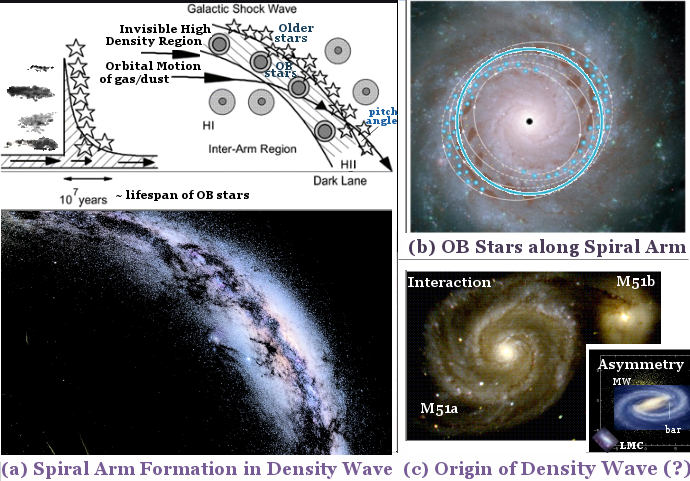
Figure 05-10a Density Wave
[view large image]
See 2020 Update on "Theory of Density Wave".
| Home Page | Overview | Site Map | Index | Appendix | Illustration | About | Contact | Update | FAQ |
 |
The formation of the spiral patterns is still a mystery because the simple model of differential rotation (rotational speed varies with distance) would produce tightly wound spirals (within 500 million years) in contrary to observation. A generally accepted mechanism (proposed in 1964) for producing the spiral structure involves wave of excess density (density wave) that gently travels around the galaxy compressing gas in its wake. This compressed gas triggers star formation and helps to explain why we see the concentration of bright young stars and clusters in the spiral arms. Figure 05-10a is a schematic model illustrating the action of a density wave, which causes stars and interstellar gas and dust to bunch up temporarily, with the spiral arm being the result of a temporary compression of material. The mechanism for the generation of |
Figure 05-10a Density Wave |
density wave is unclear, but it is thought to be similar to the traffic jam on highway (see Figure 05-10a, and a reference on the subject). See 2020 Update on "Theory of Density Wave". |
 |
The original density wave soon ran into the difficulty of energy dissipation by setting up shock waves in the interstellar gas. Complex mechanism was proposed to resolve the problem without much success. This unsatisfying state of affairs changed only in the 1980s and 1990s when gas is included into the simulations. Since gas constitutes only a few percent of the mass of spiral galaxies, it was not taken into account in previous modeling. It turns out that the gas has a disproportionate dynamical role. As soon as gas is included into the simulation, it produces a rich variety of galactic morphologies. The torque exerted by the stellar bar acts as a giant stirrer, continuously driving a spiral structure in the gas. The spiral did not fade away as it had in earlier simulations. It also explains the presence of dust lanes on the leading edge of spiral arms, the high rate of star formation in galactic center, and the refueling of the central black hole. |
Figure 05-10b [view large image] Reinvigoration |
Figure 05-10b shows the cycles of reinvigoration by the accretion of intergalactic gas into the system. |
 |
 |
align as shown in diagram b. Gravity causes the ellipses to move in unison, maintaining their alignment. The wave front is the area of greatest star density, which occurs along the major axis of the ellipses. Spiral wave arises when the ellipses move in unison but are not perfectly aligned; each ellipse is slightly skewed compared with its neighbors. The density of stars is highest where the ellipses crowd together as shown in diagram c. Diagram d shows the barred spiral pattern when orbits near the center of the galaxy are aligned but those farther out are skewed. It is thought that the alignment is caused by spontaneous gravitational instability. Because gravity in galaxies is not a |
Figure 05-10c Wave Patterns |
Figure 05-10d Wave Anatomy |
fixed external force but a product of the stars themselves, waves can be self-reinforcing. The process starts when stellar orbits become aligned by chance. Amplified by proximity, the gravity |
 |
|
Figure 05-10e |

 (click me) --- Courtesy of Wikimedia Commons
(click me) --- Courtesy of Wikimedia Commons